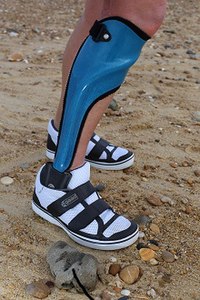
Photo from wikipedia
Stroke disease leads to a partial or complete disability affecting muscle strength and functional mobility. Early rehabilitation sessions might induce neuroplasticity and restore the affected function or structure of the… Click to show full abstract
Stroke disease leads to a partial or complete disability affecting muscle strength and functional mobility. Early rehabilitation sessions might induce neuroplasticity and restore the affected function or structure of the patients. Robotic rehabilitation minimizes the burden on therapists by providing repetitive and regularly monitored therapies. Commercial exoskeletons have been found to assist hip and knee motion. For instance, unilateral exoskeletons have the potential to become an effective training system for patients with hemiparesis. However, these robotic devices leave the ankle joint unassisted, essential in gait for body propulsion and weight-bearing. This article evaluates the effects of the robotic ankle orthosis T-FLEX during cooperative assistance with the AGoRA unilateral lower-limb exoskeleton (hip and knee actuation). This study involves nine subjects, measuring muscle activity and gait parameters such as stance and swing times. The results showed a reduction in muscle activity in the Biceps Femoris of 50%, Lateral Gastrocnemius of 59% and Tibialis Anterior of 35% when adding T-FLEX to the AGoRA unilateral lower-limb exoskeleton. No differences were found in gait parameters. Nevertheless, stability is preserved when comparing the two legs. Future works should focus on evaluating the devices in ground tests in healthy subjects and pathological patients.
Journal Title: Biosensors
Year Published: 2022
Link to full text (if available)
Share on Social Media: Sign Up to like & get
recommendations!